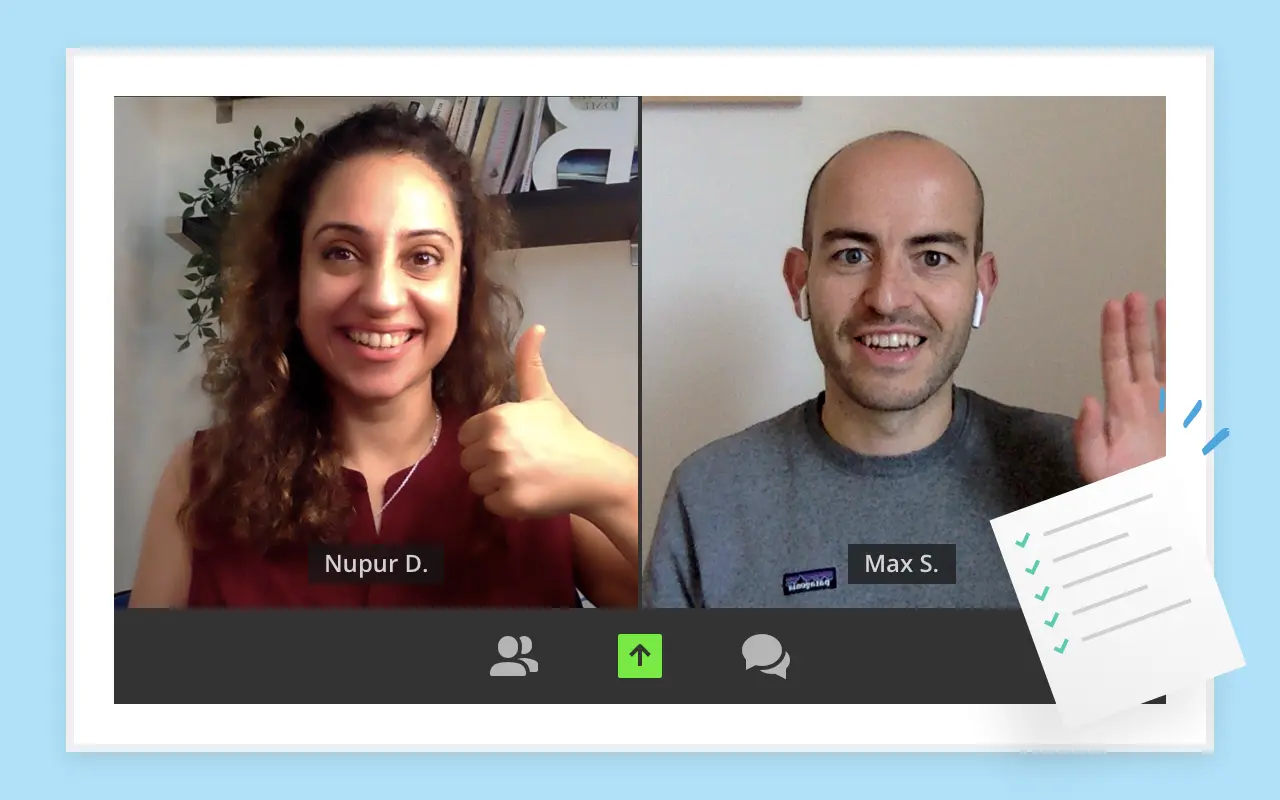Applied scientist interviews at Amazon are challenging. The questions are difficult, specific to Amazon, and cover a wide range of topics.
The good news is that the right preparation can help you maximize your chances of landing a job offer at Amazon (or Amazon Web Services/AWS). We’ve analyzed over 200 applied scientist interview experiences reported by real Amazon candidates on Glassdoor, categorized them by question type, and listed examples below.
Read on for our ultimate guide for success, including practice questions, links to helpful resources, interviewing tips, and a preparation plan to help you land that Amazon applied scientist role.
Here's an overview of what we'll cover:
- Role and salary
- Interview process and timeline
- Example interview questions
- Interviewing tips
- Preparation plan
Let’s dive in!
1. Amazon applied scientist role and salary↑
Before we cover your Amazon applied scientist interview, let’s take a look at the role itself.
1.1 What does an Amazon applied scientist do?
Amazon applied scientists use machine learning and statistical modeling to solve real-world problems that improve customer experience, reduce costs, and increase automation across the company.
As Amazon describes it, applied scientists work on a broad range of practical challenges in a rich data environment, combining experimentation with strong theoretical analysis and process innovation. The role is highly hands-on and research-driven, requiring scientists to develop new models and algorithms that can scale to millions of customers.
Applied scientists at Amazon also collaborate closely with software engineers to put models into production. This includes reviewing state-of-the-art ML methods, validating assumptions, and building robust, error-free implementations that drive real business impact.
Amazon generally has three types of scientists: Data Scientists (DS), Applied Scientists (AS), and Research Scientists (RS). DS roles involve less coding, RS roles focus on research and publications, and AS roles combine coding and research skills.
What skills are required to be an Amazon applied scientist?
Based on an analysis of current Amazon applied scientist job postings, most roles require a PhD in computer science, machine learning, statistics, or a related field. In some cases, a Master’s degree with 4+ years of relevant industry experience may also be accepted.
Most roles call for at least 1 to 3 years of experience building machine learning models for business applications, along with strong programming skills in Python, Java, or C++. You’ll also need a solid understanding of algorithms, data structures, optimization, and distributed or high-performance computing.
Depending on the position, experience with deep learning, NLP, reinforcement learning, generative AI, or LLMs may be expected. Familiarity with tools like AWS SageMaker, Spark, EMR, and Glue is often required, especially when working with large-scale data and production pipelines.
In addition to technical competency, Amazon expects you to have strong communication and collaboration skills. You’ll need to clearly explain your ideas, work effectively across teams, and help translate research into scalable, production-ready solutions.
While exact requirements may vary by team or domain, strong technical depth, applied research experience, and the ability to solve real-world problems at scale are essential for this role.
1.2 How much does an Amazon applied scientist make?
Amazon applied scientists are among the highest-paid in the industry. According to Glassdoor, they earn around 54% more than the average applied scientist in the U.S.
Levels.fyi reports even higher pay for Amazon applied scientists, with total compensation ranging from $245K at L4 to $417K at L6. Here’s a quick breakdown by level:

The average salary of Amazon's applied scientists also varies depending on location and level:
Location: Salaries are adjusted for cost of living. For example, an Amazon applied scientist at the L4 level in the U.S. typically earns significantly more than an L6 applied scientist based in India.
Level: Both base salary and total compensation go up with each AS level.
While we presume that you already know which specific level you are applying for, it’s still good to double-check this with your recruiter. Your recruiter should be able to advise you on which level you’re being evaluated.
Ultimately, how you do in your interviews will help determine what you’ll be offered. That’s why hiring one of our ex-Amazon interview coaches can provide such a significant return on investment.
And remember, compensation packages are always negotiable, even at Amazon. So, if you do get an offer, don’t be afraid to ask for more. If you need help negotiating, use this salary negotiation guide and consider booking one of our salary negotiation coaches to get expert advice.
2. Amazon applied scientist interview process and timeline↑
Here is what you can expect from the Amazon data scientist interview process and how long it typically takes.
2.1 What steps to expect
What's the Amazon interview process and timeline for the applied scientist role?
It typically takes two to three weeks and follows the steps below:
- Resume screen
- Technical phone screen: 1 or 2 interview rounds (60 minutes each)
- Interview loop: 5 or 6 interview rounds (45-60 minutes each)
Amazon’s interview process is standard for FAANG companies, with a big focus on Amazon Leadership Principles. Many candidates on Glassdoor report being asked leadership questions even during technical interviews, including the phone screen.
Amazon also follows a “2&5 Promise,” which assures candidates that they will receive an update within two business days after a phone interview (or series of interviews) and within five business days after a panel interview.
2.1.1 Resume screen
First, recruiters will review your resume and assess if your experience matches the open position. This is the most competitive step in the process, as hundreds of candidates do not make it past this stage.
If you've yet to write your resume or need tips to polish your current one, check out our Amazon resume guide for successful resume examples and best practices.
For expert feedback on your resume, you can get input from our team of ex-Amazon recruiters, who will cover what achievements to focus on (or ignore), how to fine-tune your bullet points, and more.
Of course, if you have any connections to current Amazon employees, consider asking for a referral. This often helps candidates get their feet in the door. According to Glassdoor, 22% of candidates who got an interview applied with the help of employee referrals.
2.1.2 Technical phone screen
As stated in Amazon’s interview prep guide, the technical phone screen is conducted over Amazon Chime and typically includes one or two 60-minute rounds. Each session covers a mix of behavioral, domain, and sometimes coding questions.
Behavioral questions will focus on Amazon’s Leadership Principles. Interviewers usually prefer that you structure your answers using the STAR method (Situation, Task, Action, Result).
You’ll be asked to walk through past projects, explain your decisions, and reflect on challenges or trade-offs. Make sure to prepare a few specific examples related to recent projects, team interactions, and product deliveries.
A significant portion of the interview will also assess your domain expertise, specifically:
- Science Depth: You’ll be asked to explain one of your projects in detail. From there, interviewers will dig deeper to assess your understanding of your research area, including classical methods, relevant literature, trade-offs between approaches, and how you’ve applied these in practice.
- Science Breadth: Expect general questions across machine learning and statistics. You may be asked to compare common methods (e.g., bagging vs. boosting) or explain techniques typically covered in graduate-level coursework.
Coding may also be included, especially for candidates applying to more technical teams. If so, expect one or two LeetCode-style problems, usually at the medium level. You’ll need to write syntactically correct code in your preferred language without the aid of an IDE.
Overall, the exact mix of questions depends on the role, but behavioral and domain knowledge are almost always covered. Be ready to explain your ideas clearly and show that you can apply scientific thinking to real-world problems.
2.1.3 Interview loop
If you pass the technical phone screen, you’ll move on to the Amazon interview loop. This typically includes five to six rounds, with each interview lasting 45 to 60 minutes.
Your recruiter should explain what each round covers, but essentially, you can expect a more in-depth version of your initial screen, some more behavioral questions, and more role-related knowledge questions.
The interviews are conducted one-on-one with a mix of people from the team you’re applying to join, including peers, the hiring manager, and a senior executive called the “Bar Raiser”.
Let’s break down what to expect in each round.
a. Tech talk (optional)
Depending on the team you interview with, you may be required to give a one-hour presentation to the interview panel on a topic of your choice.
You’ll need to show broad and deep knowledge of your research area. This includes familiarity with key literature, classical methods, your prior work, trade-offs between modeling approaches, relevant data sources, and practical experience in applying those research ideas to modeling problems.
Not all teams include this round, but your recruiter will let you know ahead of time if it’s part of your interview process.
b. ML depth and breadth
These interviews test how well you understand your research work (depth) and how solid your knowledge of machine learning is (breadth). More specifically:
- In the ML depth round, you'll be asked to walk through a research project you’ve worked on. Interviewers will ask follow-up questions to explore your technical decisions, the modeling trade-offs you considered, and the outcomes of your work.
- The ML breadth round focuses more on your ML knowledge. These might include topics like bagging vs. boosting, regularization, loss functions, dropout, or types of classifiers.
You may also get a few leadership questions at the end of each round that you need to connect to the project or solution you just discussed.
c. ML application round
This round tests how well you can apply machine learning to solve open-ended, practical problems in a production context.
For example, you could be given a high-level ML problem and be asked to propose a solution, including laying out possible data sources, annotation strategies, modeling techniques, evaluation metrics, and any trade-offs or risks you’d need to consider.
Toward the end of the interview, you may also get a few LP questions, typically centered on how you delivered results, made decisions under uncertainty, or navigated ambiguity in past projects.
d. Coding round
As an Amazon applied scientist, you should be able to implement modeling ideas that can be trained and tested on large-scale data. This requires a strong grasp of data structures and algorithms, along with the ability to write code.
Amazon applied scientists primarily code in Python, but you're free to use any language you're comfortable with as long as your solution is syntactically correct (no pseudocode).
In some cases, especially where latency is a constraint, you may need to understand how your code could be rewritten in Java or C++ for production.
You’ll usually be asked to solve two LeetCode-style problems at a medium difficulty level. Expect questions on recursion, trees, graphs, and other algorithm topics.
Leadership Principles may also come up during this round, so be ready to briefly explain how you’ve demonstrated specific principles in your workflow.
e. The “Bar Raiser” round
This round is led by a Bar Raiser, a specially trained interviewer who isn’t part of the team you’re applying to. Their job is to assess overall candidate quality and ensure Amazon’s hiring bar stays high across the company.
They’re known for being particularly rigorous, and getting past this round is often the final big step toward receiving an offer.
We’ll go into more detail on question types later, but expect a strong focus on Amazon’s Leadership Principles. Each interviewer is usually assigned two or three principles and will ask behavioral questions to assess how you’ve demonstrated them in past roles.
2.2 What exactly is Amazon looking for?
At the end of each interview, your interviewer will grade your performance using a standardized feedback form that summarizes the attributes Amazon looks for in a candidate. That form is constantly evolving, but we have listed some of its main components below.
A) Notes
The interviewer will file the notes they took during the interview. This usually includes the questions they asked, a summary of your answers, and any additional impressions they had (e.g., communicated ABC well, weak knowledge of XYZ, etc).
B) Technical competencies
Your interviewer will then grade you on technical competencies. They will be trying to determine whether you are "raising the bar" or not for each competency they have tested. In other words, you'll need to convince them that you are at least as good as or better than the average current Amazon applied scientist at the level you're applying for.
The exact technical competencies you'll be evaluated on may vary slightly by team, but they commonly include:
- Machine learning
- Coding
- Statistics
C) Leadership principles
Your interviewer will also grade you on Amazon's 16 Leadership Principles and assess whether you're "raising the bar" for those, too. As mentioned above, each interviewer is given two or three LPs to grill you on.
D) Overall recommendation
Finally, each interviewer will file an overall recommendation into the system. The different options are along the lines of: "Strong hire", "Hire", "No hire", and "Strong no hire".
2.3 What happens behind the scenes?
Your recruiter is leading the process and taking you from one stage to the next. Here's what happens after each of the stages we’ve just described:
- After the phone screens, your recruiter decides to move you to the onsite or not, depending on how well you've done up to that point.
- After the onsite, each interviewer files their notes into the internal system, grades you, and makes a hiring recommendation. (i.e., "Strong hire", "Hire", "No hire", "Strong no hire").
- The "Debrief" brings all your interviewers together and is led by the Bar Raiser, who is usually the most experienced interviewer and is also not part of the hiring team. The Bar Raiser will try to guide the group toward a hiring decision. It's rare, but they can also veto hiring even if all other interviewers want to hire you.
- You get an offer. If everything goes well, the recruiter will then give you an offer, usually within a week of the onsite, but it can sometimes take longer.
It's also important to note that recruiters and people who refer you have little influence on the overall process. They can help you get an interview at the beginning, but that's about it.
3. Amazon applied scientist example interview questions↑
As mentioned earlier, the Amazon applied scientist interview process includes several types of interviews, depending on the role and specialization. Here's a quick overview of the main question types you'll encounter:
- Behavioral
- Machine learning
- Coding
- Statistics
In the sections below, we’ve included example questions reported on Glassdoor for each type of interview you can expect as an Amazon applied scientist candidate. These are great example questions that you can use to start practicing for your interviews.
Let's dive right into it.
3.1 Behavioral questions↑
Amazon’s Leadership Principles tie into every step of the interview process, and interviewers will test your affinity with them through behavioral questions. Even in the technical rounds, your interviewers are looking for you to live and breathe these 16 principles, so spend extra time studying them.
If you're not already familiar with Amazon's Leadership Principles, here is the full list:

- Customer Obsession - "Leaders start with the customer and work backwards. They work vigorously to earn and keep customer trust. Although leaders pay attention to competitors, they obsess over customers.”
- Ownership - "Leaders are owners. They think long term and don’t sacrifice long-term value for short-term results. They act on behalf of the entire company, beyond just their own team. They never say ‘that’s not my job."
- Bias for Action - "Speed matters in business. Many decisions and actions are reversible and do not need extensive study. We value calculated risk taking.”
- Have Backbone; Disagree and Commit - "Leaders are obligated to respectfully challenge decisions when they disagree, even when doing so is uncomfortable or exhausting. Leaders have conviction and are tenacious. They do not compromise for the sake of social cohesion. Once a decision is determined, they commit wholly.”
- Invent and Simplify - "Leaders expect and require innovation and invention from their teams and always find ways to simplify. They are externally aware, look for new ideas from everywhere, and are not limited by ‘not invented here.’ Because we do new things, we accept that we may be misunderstood for long periods of time.”
- Dive Deep - "Leaders operate at all levels, stay connected to the details, audit frequently, and are skeptical when metrics and anecdote differ. No task is beneath them.”
- Are Right, A Lot - "Leaders are right a lot. They have strong judgment and good instincts. They seek diverse perspectives and work to disconfirm their beliefs.”
- Deliver Results - "Leaders focus on the key inputs for their business and deliver them with the right quality and in a timely fashion. Despite setbacks, they rise to the occasion and never settle.”
- Think Big - "Thinking small is a self-fulfilling prophecy. Leaders create and communicate a bold direction that inspires results. They think differently and look around corners for ways to serve customers.”
- Hire and Develop the Best - "Leaders raise the performance bar with every hire and promotion. They recognize exceptional talent, and willingly move them throughout the organization. Leaders develop leaders and take seriously their role in coaching others. We work on behalf of our people to invent mechanisms for development like Career Choice.”
- Frugality - "Accomplish more with less. Constraints breed resourcefulness, self-sufficiency, and invention. There are no extra points for growing headcount, budget size, or fixed expense.”
- Learn and Be Curious - "Leaders are never done learning and always seek to improve themselves. They are curious about new possibilities and act to explore them.”
- Insist on the Highest Standards - "Leaders have relentlessly high standards — many people may think these standards are unreasonably high. Leaders are continually raising the bar and drive their teams to deliver high quality products, services, and processes. Leaders ensure that defects do not get sent down the line and that problems are fixed so they stay fixed.”
- Earn Trust - “Leaders listen attentively, speak candidly, and treat others respectfully. They are vocally self-critical, even when doing so is awkward or embarrassing. Leaders do not believe their or their team’s body odor smells of perfume. They benchmark themselves and their teams against the best.”
- Strive to be Earth’s Best Employer - “Leaders work every day to create a safer, more productive, higher performing, more diverse, and more just work environment. They lead with empathy, have fun at work, and make it easy for others to have fun. Leaders ask themselves: Are my fellow employees growing? Are they empowered? Are they ready for what's next? Leaders have a vision for and commitment to their employees' personal success, whether that be at Amazon or elsewhere.”
- Success and Scale Bring Broad Responsibility - “We started in a garage, but we're not there anymore. We are big, we impact the world, and we are far from perfect. We must be humble and thoughtful about even the secondary effects of our actions. Our local communities, planet, and future generations need us to be better every day. We must begin each day with a determination to make better, do better, and be better for our customers, our employees, our partners, and the world at large. And we must end every day knowing we can do even more tomorrow. Leaders create more than they consume and always leave things better than how they found them.”
As you prepare for your interviews, you'll want to be strategic about practicing "stories" from your past experiences that highlight how you've embodied each of the 16 principles listed above. We'll talk more about the strategy for doing this in Section 4 below).
To help you start practicing, we've compiled the following list of behavioral questions asked at Amazon applied scientist interviews.
We’ve suggested the leadership principle that each question may be addressing. For any principles that were not reflected in the Amazon applied scientist interview questions on Glassdoor, you can check out our Amazon SDE interview guide.
Let's get to it.
Amazon applied scientist interview questions: behavioral (with related Amazon Leadership Principles)
- Why Amazon?
- Tell me about yourself
- Did you make any decisions without letting your manager know? (Principle: Ownership)
- What’s the most innovative thing you did in your project? (Principle: Invent and Simplify)
- Describe your recent works and projects (Principle: Dive Deep)
- Give me an example of a novel feature you inserted into a project. (Principle: Invent and Simplify)
- Describe one of your proudest projects (Principle: Think Big)
- Tell me about a time when you were working on an initiative or goal and saw an opportunity to do something much bigger or better than the initial focus. Did you take that opportunity? Why or why not? What was the outcome? (Principle: Think Big)
- Did you come across a scenario where the deadline given to you for a project was earlier than expected? How did you deal with it, and what was the result? (Principle: Bias for Action)
- How do you handle different opinions between colleagues? (Principle: Have Backbone; Disagree and Commit)
- Tell me about a time when the company's interest and the client's interest were not aligned (Principle: Deliver Results)
- Tell me about a time when you had to ask for time/effort to do a deep dive on a technical aspect (Principle: Deliver Results)
- List a technical challenge and how you overcame it (Principle: Deliver Results)
In addition, we also recommend practicing the behavioral questions in our Amazon behavioral interview guide, which covers a broader range of behavioral topics related to Amazon’s Leadership Principles.
3.2 Machine learning↑
Amazon applied scientists are tested on their depth and breadth of knowledge in machine learning. You may be asked to explain key concepts, compare methods, or reason through how you would design or improve a model.
Amazon’s interview guide lists the following as common topics you may be asked about in the ML rounds:
- Supervised Learning: Linear/logistic regression, decision trees, random forests, support vector machines, neural networks, gradient boosting, and evaluation metrics.
- Unsupervised Learning: Clustering (k-means, DBSCAN), anomaly detection, Gaussian mixture models (GMM), EM, and deep belief networks.
- Probabilistic Models: Bayesian networks, Markov models, Gibbs sampling, LDA, and Monte Carlo methods.
- Dimensionality Reduction: PCA, SVD, t-SNE, matrix factorization, autoencoders.
- Sequential Models: HMMs, CRFs, RNNs, and NLP applications like NER and POS tagging.
- Reinforcement Learning: Q-learning, SARSA, multi-armed bandits, and DQNs.
- Deep Learning: CNNs, RNNs, LSTMs, GANs, attention, and training challenges like vanishing gradients and dropout.
- NLP Techniques: Word2Vec, BERT, sentiment analysis, and statistical language modeling.
- Computer Vision: Object detection, image classification, CNNs, FaceNet, and YOLO.
- Training & Optimization: Loss functions, regularization, bias-variance tradeoff, and cross-validation.
- Evaluation Metrics: Accuracy, precision, recall, ROC-AUC, MAP, MRR, and A/B testing principles.
Here are some example questions from Glassdoor, grouped by the categories we just discussed.
Amazon applied scientist interview questions: machine learning
Supervised Learning
- What are the differences between supervised, unsupervised, and reinforcement learning?
- What is the closed-form solution of linear regression, and when is it better to use gradient descent?
- How does logistic regression work?\What are the differences between L1 and L2 regularization in logistic regression?
- How do ensemble methods like bagging and boosting work?
- What is the variance-bias trade-off in machine learning?
- Write the loss function for logistic regression and prove that it has a global minimum
- How do you handle data imbalance, collinearity, feature selection, and regularization in models?
- What is the difference between Boosting, Random Forest, and Bootstrap Aggregation?
- How would you design a recommendation system to suggest books to users?
- If Amazon wants to send marketing emails to potential customers, how would you model this problem?
Unsupervised Learning
- What are the common techniques used in unsupervised learning?
- What are methods for reducing dimensionality in a dataset, and how do they work?
- How would you classify products into categories and sub-categories?
Probabilistic Models
- How is KL divergence loss different from cross-entropy loss?
- What are the differences between cross-entropy loss and contrastive loss?
Dimensionality Reduction
- What are methods for reducing dimensionality in a dataset, and how do they work?
Sequential Models
- How does a BiLSTM work?
- How does a Recurrent Neural Network (RNN) work?
- How do GRU cells work, and how do they address the vanishing gradient problem?
Deep Neural Networks / Deep Learning
- How does a Convolutional Neural Network (CNN) work?
- What is Attention in machine learning models?
- What is a U-Net architecture, and what novel features does it offer?
- What are regularization procedures in deep neural networks?
- What are the basics of Artificial Neural Networks (ANNs), and what is the benefit of using ReLU activation functions?
- What happens in a neural network if you remove all the hidden layers?
- How can we use RESNET models for regression tasks?
Training & Optimization
- How do loss functions, optimizers, regularization, and feature selection impact machine learning models?
- Explain gradient descent and batch normalization. How can you accelerate, parallelize, and optimize training for memory?
- What is the Bias-Variance trade-off, and how does it affect model performance?
- What is cross-validation, and why is it important?
- Describe a few different types of cross-validation techniques
- Describe the concept of overfitting in machine learning
- What is overfitting, and how can it be identified and mitigated?
- What is the Curse of Dimensionality, and how does it impact machine learning algorithms?
- Given an existing model, how would you improve its performance or efficiency?
Evaluation Metrics
- What are common metrics for regression?
- What are common evaluation metrics for NLP tasks?
- Discuss the differences between precision, recall, and F1-score, and when you would prioritize one over the others
Others / Broad ML Application
- How would you model a warehouse inventory problem?
- Describe a recent machine learning project you worked on
- What is the next step after preparing a dataset for machine learning?
- Propose machine learning methods for two real-world use cases
- Give an example of how Forecasting is applied in machine learning
- What is the computational difference between XGBoost and Random Forest?
- Can you walk me through the process of building a machine learning model from scratch?
3.3 Coding↑
As an Amazon applied scientist, you’re expected to implement modeling ideas that can be trained and tested on large-scale data. The coding interview will test your knowledge of data structures and algorithms (DSA), your ability to write clean, syntactically correct code, and your problem-solving skills.
You’ll typically be asked to solve one or two medium-difficulty problems involving arrays, trees, graphs, dynamic programming, or modeling workflows.
You can use any programming language you are comfortable with, but you’ll be expected to write real code (not pseudocode). In most cases, you’ll be coding on a whiteboard (or the virtual equivalent).
Remember that clear communication is also important in this round. Interviewers will want to hear you explain your thought process as you solve the problem.
Practice using the example questions below.
Amazon applied scientist interview questions: coding
- Divide two integers without using multiplication, division, or modulo operations
- Given a sorted array where every element appears twice except for one element, find the unique element
- Write a function to rank IMDb films based on ratings and reviews
- Solve a graph-based problem: traverse a graph, sort live-updating data in an array, and manipulate linked lists
- Find a path through a grid maze
- Find the number of connected components in a graph
- Solve a random path problem using graph algorithms
- Solve a Two Sum variant where instead of addition, you must use multiplication
- Check if a string contains balanced parentheses
- House Robber problem from LeetCode
For more practice questions, use our list of 49 real Amazon coding interview questions.
3.4 Statistics↑
While statistics is not the primary focus of the Amazon applied scientist interview, some candidates report getting a few statistics-related questions during their rounds.
Strong statistical reasoning is important for applied scientists at Amazon, especially when it comes to building, validating, and interpreting machine learning models at scale.
Review some fundamental statistics and how to give concise explanations of statistical terms, with an emphasis on applied statistics and statistical probability. Some general topics that interviewers have asked about in previous interviews include A/B testing, normalization, and Bayes' Theorem.
Below, you’ll find a set of example statistics questions you can use for practice.
Amazon applied scientist interview questions: statistics
- What statistical methods have you used in past projects, and why did you choose them?
- Explain how you would design and evaluate an A/B test
- Why is randomization important in experimental setups?
- What is a p-value? How would you interpret it in the context of an A/B test?
- What is Maximum Likelihood Estimation (MLE)? How does it differ from Bayesian inference?
- How would you apply MLE for a regression problem?
4. Amazon applied scientist interviewing tips↑
You might be a fantastic applied scientist, but unfortunately, that won’t necessarily be enough to ace your interviews at Amazon. Interviewing is a skill in itself that you need to learn.
Let’s look at some key tips to make sure you approach your interviews in the right way.
4.1 Learn a technique for answering questions
When answering your Amazon applied scientist interview questions, you should focus on your most relevant achievements and experiences and communicate them in a clear way. An easy way to achieve this is to use a step-by-step method to tell your stories.
Some candidates on Glassdoor report that interviewers prefer you structure your answers using the STAR method (Situation-Task-Action-Result). It’s a popular framework because it’s simple and easy to remember.
However, we’ve found that a few candidates often find it difficult to distinguish between the Task and Action steps. Some also forget to include lessons learned in the Result step, which is especially important when discussing challenges or failures.
So, we’ve developed the IGotAnOffer method (SPSIL: Situation-Problem-Solution-Impact-Lessons) to correct some of the pitfalls we’ve observed when using the STAR method.
4.2 Get used to setting up the situation in 30 seconds or less
Whether you’re using the SPSIL or STAR method to answer behavioral questions, use a timer while you practice to ensure you provide only the necessary information. Spending too much time on setting up the situation is one of the most common mistakes candidates make.
4.3 Ask clarifying questions
Often, the questions you’ll be asked will be quite ambiguous, so make sure you ask questions that can help you clarify and understand the problem. Most of the questions will focus on testing your technical proficiency.
4.4 Be conversational
Amazon wants to know if you have excellent communication skills. So make sure you approach the interview like a conversation.
Amazon will also be testing you on your ability to tell a clear and concise story through data, especially to stakeholders who may or may not have a technical background. So be sure to brush up on your basics and practice interpreting them in a way that’s clear and easy for everyone to understand.
4.5 Think out loud
You need to walk your interviewer through your thought process before you actually start coding. Amazon recommends that you talk even while coding, as they want to know how you think. Your interviewer may also give you hints about whether you’re on the right track or not.
4.6 State and check assumptions
You need to explicitly state assumptions, explain why you’re making them, and check with your interviewer to see if those assumptions are reasonable.
4.7 Adapt to follow-up questions
Don’t be alarmed if your interviewer asks follow-up questions; this is perfectly normal. Listen carefully to the way your interviewer is asking these questions, as there will often be a subtle clue about the specific skills they’re looking to assess from the next part of your answer.
4.8 Present multiple possible solutions
Present multiple possible solutions if you can. Amazon wants to know your reasoning for choosing a certain solution. Amazon also wants to see how well you collaborate. So when solving problems, don’t hesitate to ask further questions and discuss your solutions with your interviewers.
Also, if you have a moonshot idea, go for it. Amazon likes candidates who think big. So, if the question allows it, try to find a way to display your creative and innovative thinking.
4.9 Be honest and authentic
Be genuine in your responses. Meta interviewers appreciate authenticity and honesty. If you faced challenges or setbacks, discuss how you improved and learned from them. When talking about failure, don’t try to hide your mistakes or frame a weakness as a strength. Instead, show what you learned and how the failure helped you grow.
4.10 Align your responses with Amazon’s Leadership Principles
This deserves mentioning here again, as Amazon interviews emphasize alignment with its leadership principles. Familiarize yourself with Amazon Leadership Principles and align your responses with them, especially behavioral responses.
5. Preparation plan↑
Now that you know what questions to expect, let's focus on how to prepare. After all, the right preparation will make the difference between failing your Amazon interviews and getting an offer.
Below is our four-step prep plan for Amazon applied scientist candidates.
5.1 Learn about Amazon's culture
Most candidates fail to do this. But before investing tens of hours preparing for an interview at Amazon, you should take some time to make sure it's actually the right company for you.
Amazon is prestigious, and it's therefore tempting to assume that you should apply without considering things more carefully. However, it's important to remember that prestige alone won't make you happy in your day-to-day work. What will make you happy is what you’ll actually be doing as well as the people you'll be working with.
If you know data scientists who work at Amazon or used to work there, talk to them to understand what the culture is like. In addition, we would recommend reading the following resources:
- Amazon's technology culture video mix (by Amazon)
- Amazon.science (by Amazon)
- Amazon’s interview loop guide (by Amazon)
- The Leadership Principles Explained by Amazon CEO Andy Jassy
- An Amazon interviewer dives deep into how she uses the Leadership Principles (by Amazon)
- Machine learning research (by Amazon)
- Amazon vision and mission analysis (by Panmore Institute)
- Amazon strategy teardown (by CB Insights)
5.2 Practice by yourself
As we've outlined above, you'll have to prepare for several different categories of questions ahead of your Amazon applied scientist interviews: behavioral (aligned with Amazon Leadersip Principles), machine learning, coding, and statistics questions. Use each category below to find resources to help you prepare.
For behavioral interview questions, we recommend learning our step-by-step method for answering behavioral questions. You can then use that method to practice answering the example questions provided in Section 3.1 above. This is especially important for Amazon’s leadership principles. Make sure you have at least one story or example for each of the principles, from a wide range of positions and projects.
For machine learning questions, Kaggle offers free courses on introductory and intermediate machine learning, as well as on data cleaning, data visualization, SQL, and other related topics. You can also find a variety of ML-related discussions and resources on Reddit’s machine learning thread.
We also recommend that you acquaint yourself with Amazon’s recent machine learning projects and findings by browsing the AWS machine learning blog and the Amazon ML science research blog.
For the coding interview questions, start with the video below that shows a step-by-step method by Amazon for answering programming questions. Practice the method using example questions such as those in section 3.3, or those relative to coding-heavy Amazon positions (e.g. Amazon software development engineer interview guide).
Also, practice SQL and programming questions with medium and hard level examples on LeetCode, HackerRank, or StrataScratch.
Take a look at Amazon’s technical topics page, which, although it’s designed around software development, should give you an idea of what they’re looking out for.
For statistics questions, Brilliant.org offers online courses designed around statistical probability and other key concepts, some of which are free. You can also search for specific questions and answers around statistics on StackExchange, or post your own for discussion in Reddit’s statistics thread.
Once you’re in command of the subject matter, you’ll want to practice answering questions. But by yourself, you can’t simulate thinking on your feet or the pressure of performing in front of a stranger. Plus, there are no unexpected follow-up questions and no feedback.
That’s why many candidates try to practice with friends or peers.
5.3 Practice with peers
If you have friends or peers who can do mock interviews with you, that's an option worth trying. It’s free, but be warned, you may come up against the following problems:
- It’s hard to know if the feedback you get is accurate
- They’re unlikely to have insider knowledge of interviews at your target company
- On peer platforms, people often waste your time by not showing up
For those reasons, many candidates skip peer mock interviews and go straight to mock interviews with an expert.
5.4 Practice with experienced ex-Amazon interviewers
In our experience, practicing real interviews with experts who can give you company-specific feedback makes a huge difference.
Find an Amazon interview coach so you can:
- Test yourself under real interview conditions
- Get accurate feedback from a real expert
- Build your confidence
- Get company-specific insights
- Learn how to tell the right stories, better.
- Save time by focusing your preparation
Landing a job at a big tech company often results in a $50,000 per year or more increase in total compensation. In our experience, three or four coaching sessions worth ~$500 will make a significant difference in your ability to land the job. That’s an ROI of 100x!















